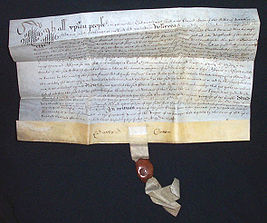Vellum
Vellum (diturunkan dari kata Latin “vitulinum” artinya "dibuat dari sapi muda", yang menjadi istilah bahasa Perancis kuno “Vélin”, artinya "kulit sapi muda"; "calfskin") adalah sebutan bagi lembaran untuk menulis yang terbuat dari kulit sapi muda,[1] dan bukan dari kulit binatang lain.[2] Biasanya dipersiapkan untuk ditulisi atau bahan cetakan, guna menghasilkan halaman-halaman tunggal, gulungan, kodeks atau buku. Istilah ini seringkali digunakan lebih luas untuk menyebut perkamen berkualitas halus yang terbuat dari berbagai kulit binatang.

Vellum umumnya halus dan tahan lama, meskipun ada variasi besar tergantung cara penyiapan dan kualitas kulit. Pembuatannya meliputi pembersihan, pemutihan, pembentangan pada suatu kerangka (suatu "herse"), dan pengerutan permukaan kulit dengan pisau berbentuk sabit (sebuah “lunarium” atau “lunellum”). Untuk menghasilkan suatu tensi, kerutan diselang seling dengan pembasahan dan pengeringan. Hasil akhir dicapai dengan menggosok permukaan menggunakan suatu pumice, dan membubuhkan larutan kalsium hidroksida (lime) atau kapur untuk membuat permukaan itu dapat menerima tinta tulisan atau cetak.[2]
"Kertas vellum" modern (vellum dari sayuran) sangat berbeda dengan material sintetis, digunakan untuk berbagai tujuan termasuk, peta, gambar teknis dan cetak biru.. ]</ref> It is still used for Jewish scrolls, of the Torah in particular, for luxury book-binding, memorial books, and for various documents in calligraphy.
Today, because of low demand and complicated manufacturing process, animal vellum is expensive and hard to find. The only UK company still producing traditional parchment and vellum is William Cowley (Est 1870) who are based in Newport Pagnell, Buckinghamshire. A modern imitation is made out of cotton. Known as paper vellum, this material is considerably cheaper than animal vellum and can be found in most art and drafting supply stores. Some brands of writing paper and other sorts of paper use the term "vellum" to suggest quality.
Vellum is still used on instruments such as the banjo and the bodhran, although synthetic skins are also available for these instruments.
Paper vellum
Modern imitation or "paper vellum" is made from plasticized cotton. Usually translucent, paper vellum in various sizes is often used in applications where tracing is required, such as architectural plans. Like natural vellum,[butuh rujukan] the synthetic is more dimensionally stable than a linen or paper sheet, which is frequently critical in the development of large scaled drawings and plans such as blueprints. It was also extremely important in that reproduction technology for dissemination of the plans as, like a high quality natural vellum, it could be produced in a thin enough sheet to be virtually transparent to strong light enabling a source drawing to be used directly in the reproduction of field-used drawings.
Preservation
True vellum is typically stored in a stable environment with constant temperature and 30% (± 5%) relative humidity. If vellum is stored in an environment with less than 11% relative humidity, it becomes fragile, brittle, and susceptible to mechanical stresses; if it is stored in an environment with greater than 40% relative humidity, it becomes vulnerable to gelation and to mold or fungus growth.[3] The optimal temperature for the preservation of vellum is 20 ± 1.5 °C (68 ± 3 °F). -->
Lihat pula
Referensi
- ^ Online Etymological Dictionary
- ^ a b http://www.archives.gov/preservation/formats/paper-vellum.html
- ^ Eric F. Hansen and Steve N. Lee, “The Effects of Relative Humidity on Some Physical Properties of Modern Vellum: Implications for the Optimum Relative Humidity for the Display and Storage of Parchment,” The Book and Paper Group Annual (1991).